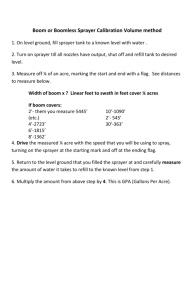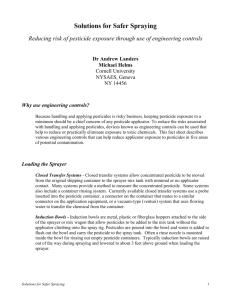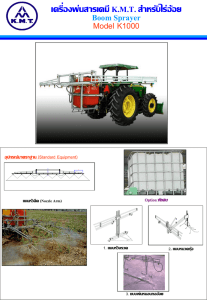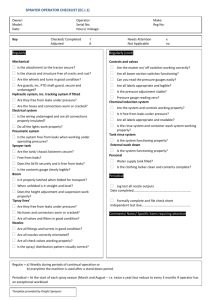PREPARING THE CROP SPRAYER FOR WORK
advertisement
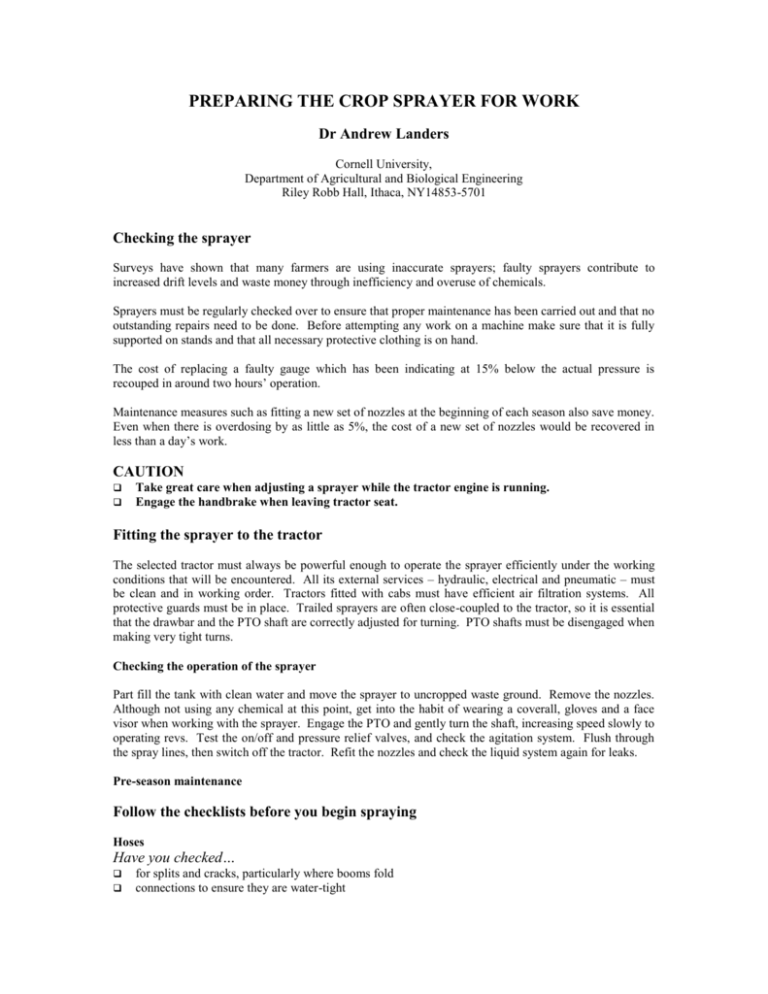
PREPARING THE CROP SPRAYER FOR WORK Dr Andrew Landers Cornell University, Department of Agricultural and Biological Engineering Riley Robb Hall, Ithaca, NY14853-5701 Checking the sprayer Surveys have shown that many farmers are using inaccurate sprayers; faulty sprayers contribute to increased drift levels and waste money through inefficiency and overuse of chemicals. Sprayers must be regularly checked over to ensure that proper maintenance has been carried out and that no outstanding repairs need to be done. Before attempting any work on a machine make sure that it is fully supported on stands and that all necessary protective clothing is on hand. The cost of replacing a faulty gauge which has been indicating at 15% below the actual pressure is recouped in around two hours’ operation. Maintenance measures such as fitting a new set of nozzles at the beginning of each season also save money. Even when there is overdosing by as little as 5%, the cost of a new set of nozzles would be recovered in less than a day’s work. CAUTION Take great care when adjusting a sprayer while the tractor engine is running. Engage the handbrake when leaving tractor seat. Fitting the sprayer to the tractor The selected tractor must always be powerful enough to operate the sprayer efficiently under the working conditions that will be encountered. All its external services – hydraulic, electrical and pneumatic – must be clean and in working order. Tractors fitted with cabs must have efficient air filtration systems. All protective guards must be in place. Trailed sprayers are often close-coupled to the tractor, so it is essential that the drawbar and the PTO shaft are correctly adjusted for turning. PTO shafts must be disengaged when making very tight turns. Checking the operation of the sprayer Part fill the tank with clean water and move the sprayer to uncropped waste ground. Remove the nozzles. Although not using any chemical at this point, get into the habit of wearing a coverall, gloves and a face visor when working with the sprayer. Engage the PTO and gently turn the shaft, increasing speed slowly to operating revs. Test the on/off and pressure relief valves, and check the agitation system. Flush through the spray lines, then switch off the tractor. Refit the nozzles and check the liquid system again for leaks. Pre-season maintenance Follow the checklists before you begin spraying Hoses Have you checked… for splits and cracks, particularly where booms fold connections to ensure they are water-tight for hose chafe, particularly in routing clips Action: Replace damaged hoses. Filters Have you checked… for missing filter elements and seals for leakage for blocked or damaged filters Action: Replace any damaged or blocked filters. Tank Have you checked… for fractures and any other damage the tank sits firmly in its mount the securing straps are correctly adjusted the agitation is working the tank is clean Action: See the supplier/manufacturer now about fractures and any other repairs. Controls Have you checked… the control circuitry (electrical, hydraulic or air) for correct operation valves for both internal and external leaks Action: Replace leaky valves, which waste money and are potentially dangerous to operators and the environment. Pump Have you checked… lubrication levels for leakages the air pressure in the pulsation chamber (if fitted) is at the recommended level the pump rotates freely without friction or noise. Do so by rotating manually or starting at low speed (corrosion may cause seizing up) Pressure Gauge The pressure gauge is vital for indicating whether the nozzles are delivering the correct amount of chemical per unit time while spraying. If you have any doubts about the pressure gauge, replace it or refer the problem to the manufacturer or supplier. Boom The boom suspension must operate smoothly to ensure a stable ‘nozzle platform’. Have you checked… friction plates, dampers, shock absorbers, pivots and slides – and scheduled future maintenance boom movement and stability* the boom folding mechanism the height adjustment mechanism for correct functioning for distortion or sagging the break backs for correct operation *The boom movement must be free but not too loose: for a 40 foot boom, the tip should return to within 2’’ of its original height after a vertical displacement of 12’’ or more. Boom Piping Have you checked… the condition of all pipework the nozzle bodies for damage or loose fit for any damaged units, and replaced them for leaks under pressure Action: remove the boom end caps and flush clean water through. Anti-drip valves Avoid leaks by keeping these small valves, above or to one side of each nozzle, in good repair. Damaged diaphragms and seats will lead to faulty functioning. Examine all units under pressure to test for leaks and correct cut-off action. Nozzles Have you checked… all nozzles on the boom are the same all nozzles are in good condition, with no evidence of streaks or irregularities in the spray pattern all nozzles are clean and free from obstruction (note: clean with a soft brush or airline – don’t damage nozzles by using wires or pins) all nozzles deliver to within + or - 5% of the manufacturer’s chart value Action: Always ensure the correct nozzles and operating pressure are selected before use. Have two or three sets of nozzles in stock to meet different spray qualities at different volume rates. Inspect nozzles throughout the season to avoid faults which could prove both costly and damaging to the environment if they develop unchecked. Using water only, set to ‘spray’ at the specified pressure and collect the output from each nozzle in turn for a period of 60 seconds. Record each output and replace those outside the 5% tolerance around the manufacturer’s chart value. Calibration Where your sprayer has automatic controllers to monitor the speed of the sprayer and the flow, pressure and area sprayed, have you checked… they are in good condition and properly maintained they are frequently calibrated for accuracy, with calibration being checked after every 250 acres’ use for leaks, blockages, variations in pressure or any minor damage during spraying A recommended calibration technique is summarised as: Read the label Measure the forward travel speed of the tractor with the booms out and over the field to be sprayed Calculate the nozzle output required Select the appropriate nozzle set Set the appropriate pressure Measure the nozzle output against time Routine maintenance The following checks should be carried out routinely: __All hoses are tightly connected and free from sharp bends; cracked or damaged hoses must be replaced. __All controls move freely and are fully adjustable. __Pressure gauge reads zero. __Pump can be turned over by hand. __Air pressure in pump accumulator (if fitted) is correctly adjusted. __Drain plugs and clean filters are in position. __Tyres on trailed machines are sound and correctly inflated; wheel nuts are tight. Travel Speed Calibration Travel speed is a critical factor in maintaining accurate application rates and will influence spray deposition depending on location within the canopy. The slower a sprayer travels, the greater the uniformity in spray deposition. Although there is inconsistency in research results that try to determine the effect of travel speed on average spray deposition, all studies to date have been in agreement that the higher the travel speed, the greater the variability in spray deposit. Variation in spray deposit is an important factor where uniformity of spray coverage throughout the canopy is required. Conclusions from research were drawn using travel speeds of 1-4 mph. Factors that will affect travel speed include: weight of sprayer to be pulled slope of terrain ground conditions traveled over (wheel slippage!) The best way to measure travel speed is to pull a sprayer with tank half filled with water on the same type of terrain that the sprayer will be operated on. Set up test course at least 100 feet long, measure the course with a tape measure. Do not pace the distance. The longer the course the smaller the margin of error. Run the course in both directions. Use an accurate stop watch to check the time required to travel the course in each direction. Average the two runs and use the following formula to calculate the speed in MPH. Formula: MPH = feet traveled X 60 seconds traveled 88 Your figures: Tractor gear___________ Engine revs.___________ MPH = Feet traveled X 60 = Seconds traveled 88 ________ = Boom Sprayer Calibration - use clean water Step 1. Check your tractor/sprayer speed Formula: MPH = ft. traveled X 60 sec. traveled 88 Your tractor sprayer speed: MPH = ft. traveled X 60 sec. traveled 88 = ________ = Step 2. Record the inputs Your figures Step 3. Example Nozzle type on your sprayer (all nozzles must be identical) ________________ 110 04 flat fan Recommended application volume (from manufacturer’s label) ________________ 20 GPA Measured sprayer speed ________________ 4 mph Nozzle spacing ________________ 20 inches Calculate the required nozzle output. Formula: GPM = GPA X mph X nozzle spacing 5940 (constant) Example: GPM = 20 X 4 X 20 = 1600 = 0.27 GPM 5940 5940 Your figures: GPM = X 5940 X . = ________ = 5940 GPM Step 4. Operate the sprayer Set the correct pressure at the gauge using the pressure regulating valve. Collect and measure the output of each nozzle for one minute. The output of each nozzle should be the approximately the same as calculated in Step 3 above. Remember 128 fl. ozs in one gallon. If output has been calculated at 0.27 GPM then output is 128 multiplied by 0.27 = 34.5 fl.ozs in one minute. Replace all nozzle tips which are more than 5% inaccurate. Banded boom sprayer calibration. The only difference between the boom sprayer calibration mentioned above and calibrating for a banded sprayer is the input value used in the formula in Step 3. For a single nozzle banding applications: Nozzle spacing = sprayed band width or swath width (in inches) For multiple nozzle directed applications: Nozzle spacing = row spacing (in inches) divided by the number of Nozzles per row. Correct nozzle selection is one of the most important yet inexpensive aspects of pesticide application. A nozzle’s droplet size spectrum determines deposition and drift. Conventional flat fan nozzles fitted to a crop sprayer produces droplets in the range of 10 – 450 microns. There are 25,000 microns in one inch. Drift is a major problem with droplets less than 100 microns. Increasing the Volume Median Diameter (VMD) will certainly reduce drift, but too large a droplet will bounce off the leaves to the ground, thus causing pollution, wasting money and resulting in less product on the target. Drift has been a major concern for some years, off target application wastes money, reduces deposition on the target plant, pollutes water courses and may cause nausea to other people. Conventional flat fan nozzles Nozzles with 800 degree angle produce coarser droplets than 1100 at the same flow rate but 800 nozzles require the boom to be set at 17-19 inches whereas 1100 nozzles can be set lower at 15-18 inches above the target. (The lower the boom, the less chance of drift). Spray quality is fine – medium at 15- 60 psi Pre-orifice flat fan nozzles The internal design of this nozzle reduces the internal operating pressure compared to a conventional flat fan resulting in coarser droplets ( high pressure creates fine droplets, low pressure creates coarser droplets). Available as 800 or 1100 nozzles. Spray quality is medium - coarse at 30- 60 psi. Drift-guard is a well-known trade name. Turbo-teejet A turbulence chamber produces a wide angle flat spray pattern of 1500. Spray quality is medium – coarse at 15- 90 psi. Nozzles can be set at 15-18 inches above the target. Air induction nozzles Air induction, air inclusion or venturi nozzles are flat fan nozzles where an internal venturi creates negative pressure inside the nozzle body. Air is drawn into the nozzle through two holes in the nozzle side, mixing with the spray liquid. The emitted spray contains large droplets filled with air bubbles (similar to a candy malt ball) and virtually no fine, drift-prone droplets. The droplets explode on impact with leaves and produce similar coverage to conventional, finer sprays. Air induction nozzles reduce drift even at higher pressures of 80-90 psi. They are only available at 110º fan angles so boom height may need to be adjusted to 15-18 inches. The use of adjuvants will certainly help create bubbles and trials in Europe confirm this. Air induction nozzles are regarded as expensive, the list price is three times the cost of a conventional flat fan tip, although some nozzle suppliers in NY will supply for approximately twice the cost. Manufacturers include: Greenleaf TurboDrop nozzles consist of two primary components - the venturi air aspirator and the exit pattern tip. A ceramic orifice in the venturi determines the flow rate of the complete assembly. The venturi is ISO color coded to designate flow rate. The exit pattern tip does not affect flow rate: it is only used to form the desired spray pattern. Pressure range is 40-90 psi. Spraying Systems Tee Jet Air Induction (AI) comprises a plastic body with a steel tip, rated for 30 to 100 psi. They are plastic, single-piece construction. Hardi air induction is similar in construction to Spraying Systems AI nozzle, it is a one piece plastic nozzle. Albuz is similar in construction to Spraying Systems AI nozzle, it is a one piece plastic nozzle with a ceramic tip. Correct nozzle selection is one of the most important yet inexpensive aspects of pesticide application. A nozzle’s droplet size spectrum determines deposition and drift. Conventional flat fan nozzles fitted to a crop sprayer produces droplets in the range of 10 – 450 microns. There are 25,000 microns in one inch. Drift is a major problem with droplets less than 100 microns. Increasing the Volume Median Diameter (VMD) will certainly reduce drift, but too large a droplet will bounce off the leaves to the ground, thus causing pollution, wasting money and resulting in less product on the target. Drift has been a major concern for some years, off target application wastes money, reduces deposition on the target plant, pollutes water courses and may cause nausea to other people. Conventional flat fan nozzles Nozzles with 800 degree angle produce coarser droplets than 1100 at the same flow rate but 800 nozzles require the boom to be set at 17-19 inches whereas 1100 nozzles can be set lower at 15-18 inches above the target. (The lower the boom, the less chance of drift). Spray quality is fine – medium at 15- 60 psi Pre-orifice flat fan nozzles The internal design of this nozzle reduces the internal operating pressure compared to a conventional flat fan resulting in coarser droplets ( high pressure creates fine droplets, low pressure creates coarser droplets). Available as 800 or 1100 nozzles. Spray quality is medium - coarse at 30- 60 psi. Drift-guard is a well-known trade name. Turbo-teejet A turbulence chamber produces a wide angle flat spray pattern of 1500. Spray quality is medium – coarse at 15- 90 psi. Nozzles can be set at 15-18 inches above the target. Air induction nozzles Air induction, air inclusion or venturi nozzles are flat fan nozzles where an internal venturi creates negative pressure inside the nozzle body. Air is drawn into the nozzle through two holes in the nozzle side, mixing with the spray liquid. The emitted spray contains large droplets filled with air bubbles (similar to a candy malt ball) and virtually no fine, drift-prone droplets. The droplets explode on impact with leaves and produce similar coverage to conventional, finer sprays. Air induction nozzles reduce drift even at higher pressures of 80-90 psi. They are only available at 110º fan angles so boom height may need to be adjusted to 15-18 inches. The use of adjuvants will certainly help create bubbles and trials in Europe confirm this. Air induction nozzles are regarded as expensive, the list price can be three times the cost of conventional flat fan nozzles.
